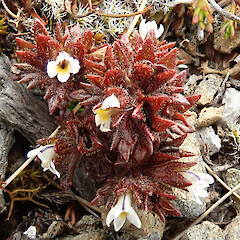Euphrasia zelandica
Common name
eyebright
Family
Orobanchaceae
Flora category
Vascular – Native
Endemic taxon
Yes
Endemic genus
No
Endemic family
No
Structural class
Herbs - Dicotyledons other than Composites
NVS code
The National Vegetation Survey (NVS) Databank is a physical archive and electronic databank containing records of over 94,000 vegetation survey plots - including data from over 19,000 permanent plots. NVS maintains a standard set of species code abbreviations that correspond to standard scientific plant names from the Ngä Tipu o Aotearoa - New Zealand Plants database.
EUPZEL
Current conservation status
The conservation status of all known New Zealand vascular plant taxa at the rank of species and below were reassessed in 2017 using the New Zealand Threat Classification System (NZTCS) – more information about this can be found on the NZTCS website. This report includes a statistical summary and brief notes on changes since 2012 and replaces all previous NZTCS lists for vascular plants.
Please note, threat classifications are often suggested by authors when publications fall between NZTCS assessment periods – an interim threat classification status has not been assessed by the NZTCS panel.
- Conservation status of New Zealand indigenous vascular plants, 2017 . 2018. Peter J. de Lange, Jeremy R. Rolfe, John W. Barkla, Shannel P. Courtney, Paul D. Champion, Leon R. Perrie, Sarah M. Beadel, Kerry A. Ford, Ilse Breitwieser, Ines Schönberger, Rowan Hindmarsh-Walls, Peter B. Heenan and Kate Ladley. Department of Conservation. Source: NZTCS and licensed by DOC for reuse under the Creative Commons Attribution 4.0 International licence.
2017 | Not Threatened
Previous conservation statuses
2012 | Not Threatened
2009 | Not Threatened
2004 | Not Threatened
Distribution
Endemic. North Island, South Island from Mount Hikurangi southwards.
Habitat
Montane to subalpine boggy to dry open places
Wetland plant indicator status rating
Information derived from the revised national wetland plant list prepared to assist councils in delineating and monitoring wetlands (Clarkson et al., 2021 Manaaki Whenua – Landcare Research Contract Report LC3975 for Hawke’s Bay Regional Council). The national plant list categorises plants by the extent to which they are found in wetlands and not ‘drylands’. The indicator status ratings are OBL (obligate wetland), FACW (facultative wetland), FAC (facultative), FACU (facultative upland), and UPL (obligate upland). If you have suggestions for the Wetland Indicator Status Rating, please contact: [Enable JavaScript to view protected content]
FAC: Facultative
Commonly occurs as either a hydrophyte or non-hydrophyte (non-wetlands).
Detailed description
Small, succulent-like annual herb 20-100 mm tall, simple, or branched from base, sometimes minute and flowering when less than 10 mm tall; branches ascending, bifariously white-pubescent, occasionally with short glandular hairs towards tips. Leaves sessile, usually rather distant in lower parts of branches and crowded towards tips, sometimes forming small rosette, approximately 4-9 x 2-6 mm, ovate to suborbicular or flabellate with 2-5 pairs of narrow acute teeth, cuneately narrowed to base, margins thickened and revolute, upper surface clad in short flattened white hairs sometimes mixed with short glandular hairs, occasionally nearly glabrous, lower surface glabrous or sparsely hairy. Flowers, clustered at tips of branches, subsessile or on pedicels up to 4 mm long, sometimes pedicels longer, especially in fruit. Calyx (4)-5-(6) mm long, sometimes much enlarged in fruit, pubescent as leaves, divided 1/3 to nearly 1/2 way; lobes acute, margins and midveins thickened and reddish. Corolla white, 6-10-(12) mm long; tube narrow, slightly to much longer than calyx; lobes of lower lip 1-2 mm wide, entire, obtuse to subacute. Anthers yellow to golden brown, margins glabrous or nearly so, awns slender, approximately equal. Capsule greater than or approximately equal to calyx, 4-8 x 3-5 mm, obovate, setose at apex; seeds numerous, 1-1.5 mm long.
Similar taxa
Similar in appearance to Euphrasia australis which is generally larger in stature than E. zelandica, up to 200 mm high compared to 100 mm, having a stouter appearance. The flower pedicels are shorter on E. zelandica, up to 4 mm, compared to up to 10 mm in E. australis. Euphrasia australis has longer sparse glandular hairs compared to generally many shorter white hairs on E. zelandica. Euphrasia australis has a limited range being restricted to West Otago and Fiordland, whereas E. zelandica has a greater distribution range.
Flowering
October - April
Flower colours
White, Yellow
Fruiting
February - April
Life cycle
Seeds is dispersed by wind and possibly water and ballistic projection (Thorsen et al., 2009).
Etymology
euphrasia: Eye-medicine
TAXONOMIC NOTES
Allan (1961) notes, although extreme forms appear very distinct in E. zelandica and E. australis the two species are not always satisfactorily separable; the size differences may be largely epharmonic, and elongated plants with pedicels shorter than leaves sometimes have the pubescence of E. zelandica.
Crossing appears to occur quite freely between E. cockayneana and E. zelandica where they occur together, e.g. at Arthur’s Pass, where plants combining characters of both species sometimes out-number pure individuals of E. zelandica. The putative hybrids are intermediate in habit with white to cream corollas of intermediate size and a mingling of the characteristic leaf-pubescence of both species. Even plants superficially closely resembling E. zelandica may have the stiff appressed scabridity of E. cockayneana on the leaf-margins.
Attribution
Fact sheet prepared for NZPCN by M.D. Ward (2 November 2020). Description adapted from Allan (1961).
References and further reading
Allan, H. H. 1961. Flora of New Zealand. Volume 1. Wellington: Government Printer. Pages 856-857.
Thorsen, M. J.; Dickinson, K. J. M.; Seddon, P. J. 2009. Seed dispersal systems in the New Zealand flora. Perspectives in Plant Ecology, Evolution and Systematics 11: 285-309.
NZPCN Fact Sheet citation
Please cite as: Ward, M.D. (Year at time of access): Euphrasia zelandica Fact Sheet (content continuously updated). New Zealand Plant Conservation Network. https://www.nzpcn.org.nz/flora/species/euphrasia-zelandica/ (Date website was queried)








